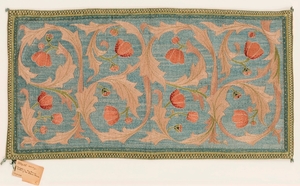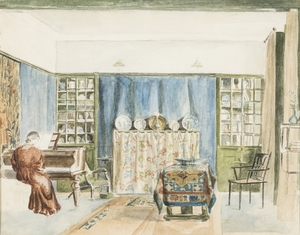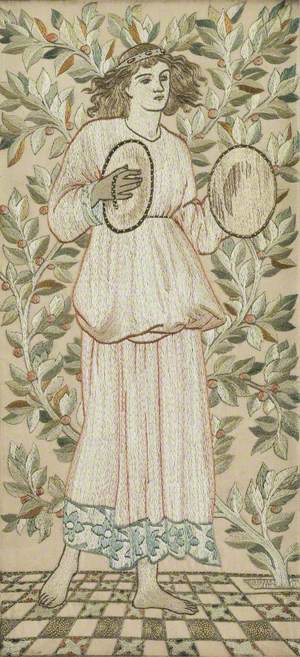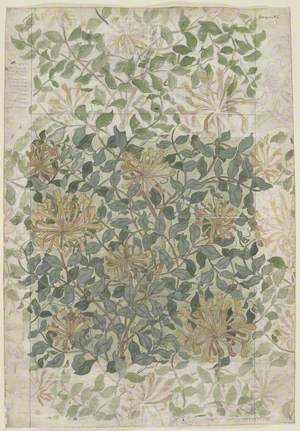- Artist: Morris, May, 1862–1938 Remove
- Save search
May Morris
1862–1938
Mary Morris [commonly known as May Morris; also known as May Sparling ] was born at the Red House, Bexleyheath, Kent, England on 25 March 1862 and was the youngest daughter of the artist, designer, writer and libertarian socialist William Morris (1834-1896) and Jane Morris [née Burden] (1839-1914), an embroiderer and artists' model.
Text Source: Arts + Architecture Profiles from Art History Research net (AHRnet) https://www.arthistoryresearch.net/
-
Westward Ho! Embroidery 1885 Jane Morris (1839–1914) and May Morris (1862–1938)Westward Ho! Embroidery 1885 Kelmscott House
-
End of the Drawing Room at Kelmscott House c.1878–1881 May Morris (1862–1938)End of the Drawing Room at Kelmscott House c.1878–1881 William Morris Gallery
-
Minstrel with Cymbals Embroidery 1885 May Morris (1862–1938)Minstrel with Cymbals Embroidery 1885 Kelmscott House
-
Design for Honeysuckle Wallpaper 1881 May Morris (1862–1938)Design for Honeysuckle Wallpaper 1881 Kelmscott House
-
 Design for the 'Kelmscott' bedspread: flower design with many flower heads and stems converging below 1910 May Morris (1862–1938)Design for the 'Kelmscott' bedspread: flower design with many flower heads and stems converging below 1910 Ashmolean Museum, Oxford
Design for the 'Kelmscott' bedspread: flower design with many flower heads and stems converging below 1910 May Morris (1862–1938)Design for the 'Kelmscott' bedspread: flower design with many flower heads and stems converging below 1910 Ashmolean Museum, Oxford -
 Bookcover design with pomegranate, flowers and hearts 1877 - 1938 May Morris (1862–1938)Bookcover design with pomegranate, flowers and hearts 1877 - 1938 Ashmolean Museum, Oxford
Bookcover design with pomegranate, flowers and hearts 1877 - 1938 May Morris (1862–1938)Bookcover design with pomegranate, flowers and hearts 1877 - 1938 Ashmolean Museum, Oxford -
 Border pattern for sleeve of embroidered Egyptian cloak, with two diamond and three triangle motifs with stylized leaf edging strip 1896 May Morris (1862–1938)Border pattern for sleeve of embroidered Egyptian cloak, with two diamond and three triangle motifs with stylized leaf edging strip 1896 Ashmolean Museum, Oxford
Border pattern for sleeve of embroidered Egyptian cloak, with two diamond and three triangle motifs with stylized leaf edging strip 1896 May Morris (1862–1938)Border pattern for sleeve of embroidered Egyptian cloak, with two diamond and three triangle motifs with stylized leaf edging strip 1896 Ashmolean Museum, Oxford -
 Pattern for the hem of a dress or sleeve, with lotus flower motif 1890 - 1930 May Morris (1862–1938)Pattern for the hem of a dress or sleeve, with lotus flower motif 1890 - 1930 Ashmolean Museum, Oxford
Pattern for the hem of a dress or sleeve, with lotus flower motif 1890 - 1930 May Morris (1862–1938)Pattern for the hem of a dress or sleeve, with lotus flower motif 1890 - 1930 Ashmolean Museum, Oxford -
 Pounced design for a cushion cover, with birds and foliage 1890 - 1910 May Morris (1862–1938)Pounced design for a cushion cover, with birds and foliage 1890 - 1910 Ashmolean Museum, Oxford
Pounced design for a cushion cover, with birds and foliage 1890 - 1910 May Morris (1862–1938)Pounced design for a cushion cover, with birds and foliage 1890 - 1910 Ashmolean Museum, Oxford -
 Study of a twisting tree trunk, possibly olive 1877 - 1878 May Morris (1862–1938)Study of a twisting tree trunk, possibly olive 1877 - 1878 Ashmolean Museum, Oxford
Study of a twisting tree trunk, possibly olive 1877 - 1878 May Morris (1862–1938)Study of a twisting tree trunk, possibly olive 1877 - 1878 Ashmolean Museum, Oxford -
 Study of a tabby cat, for 'The Hunter at Bay' 1934 - 1935 May Morris (1862–1938)Study of a tabby cat, for 'The Hunter at Bay' 1934 - 1935 Ashmolean Museum, Oxford
Study of a tabby cat, for 'The Hunter at Bay' 1934 - 1935 May Morris (1862–1938)Study of a tabby cat, for 'The Hunter at Bay' 1934 - 1935 Ashmolean Museum, Oxford -
 Two studies of a rose 1890 - 1905 May Morris (1862–1938)Two studies of a rose 1890 - 1905 Ashmolean Museum, Oxford
Two studies of a rose 1890 - 1905 May Morris (1862–1938)Two studies of a rose 1890 - 1905 Ashmolean Museum, Oxford -
 'LW' monogram within a circular frame: design for an embroidery pattern 1890 - 1900 May Morris (1862–1938)'LW' monogram within a circular frame: design for an embroidery pattern 1890 - 1900 Ashmolean Museum, Oxford
'LW' monogram within a circular frame: design for an embroidery pattern 1890 - 1900 May Morris (1862–1938)'LW' monogram within a circular frame: design for an embroidery pattern 1890 - 1900 Ashmolean Museum, Oxford -
 Studies of wild strawberry and Tormentil (potentilla erecta) 1877 May Morris (1862–1938)Studies of wild strawberry and Tormentil (potentilla erecta) 1877 Ashmolean Museum, Oxford
Studies of wild strawberry and Tormentil (potentilla erecta) 1877 May Morris (1862–1938)Studies of wild strawberry and Tormentil (potentilla erecta) 1877 Ashmolean Museum, Oxford -
 Study of a holly stem, possibly ilex pyramidalis 1879 May Morris (1862–1938)Study of a holly stem, possibly ilex pyramidalis 1879 Ashmolean Museum, Oxford
Study of a holly stem, possibly ilex pyramidalis 1879 May Morris (1862–1938)Study of a holly stem, possibly ilex pyramidalis 1879 Ashmolean Museum, Oxford -
 Border design for ecclesiastical textile Ego Flos Campi, with three stylized Persian motifs 1910 - 1938 May Morris (1862–1938)Border design for ecclesiastical textile Ego Flos Campi, with three stylized Persian motifs 1910 - 1938 Ashmolean Museum, Oxford
Border design for ecclesiastical textile Ego Flos Campi, with three stylized Persian motifs 1910 - 1938 May Morris (1862–1938)Border design for ecclesiastical textile Ego Flos Campi, with three stylized Persian motifs 1910 - 1938 Ashmolean Museum, Oxford -
 Design for an ecclesiastical glove 1899 - 1900 May Morris (1862–1938) and Charles S. Ricketts (1866–1931)Design for an ecclesiastical glove 1899 - 1900 Ashmolean Museum, Oxford
Design for an ecclesiastical glove 1899 - 1900 May Morris (1862–1938) and Charles S. Ricketts (1866–1931)Design for an ecclesiastical glove 1899 - 1900 Ashmolean Museum, Oxford -
 Pattern for an embroidered bag, with scrolling flower and leaf design 1890 - 1900 May Morris (1862–1938)Pattern for an embroidered bag, with scrolling flower and leaf design 1890 - 1900 Ashmolean Museum, Oxford
Pattern for an embroidered bag, with scrolling flower and leaf design 1890 - 1900 May Morris (1862–1938)Pattern for an embroidered bag, with scrolling flower and leaf design 1890 - 1900 Ashmolean Museum, Oxford -
 In Hortu Paradisi: St Dorothy with the angel 1910 - 1938 May Morris (1862–1938)In Hortu Paradisi: St Dorothy with the angel 1910 - 1938 Ashmolean Museum, Oxford
In Hortu Paradisi: St Dorothy with the angel 1910 - 1938 May Morris (1862–1938)In Hortu Paradisi: St Dorothy with the angel 1910 - 1938 Ashmolean Museum, Oxford -
 Burn of Force: study of berries 1905 May Morris (1862–1938)Burn of Force: study of berries 1905 Ashmolean Museum, Oxford
Burn of Force: study of berries 1905 May Morris (1862–1938)Burn of Force: study of berries 1905 Ashmolean Museum, Oxford



